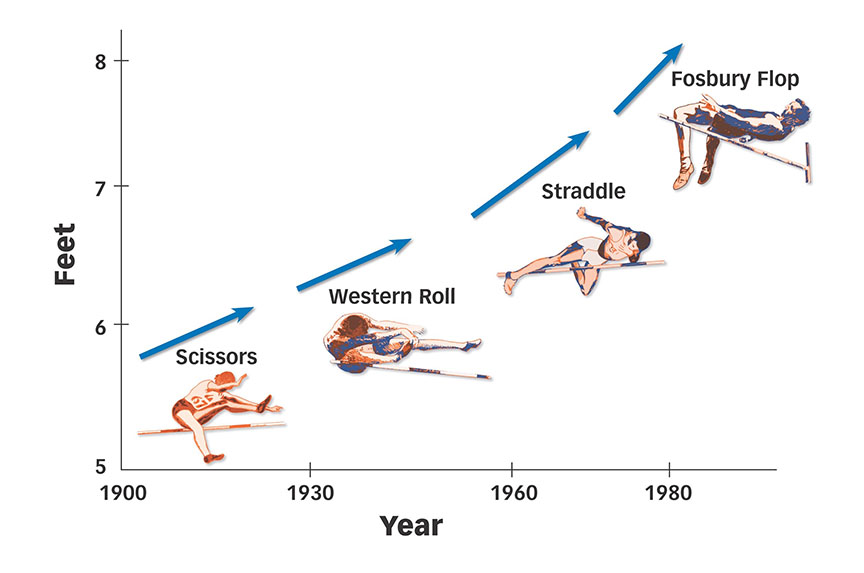
In a world of rapid change, static methods of strategic planning won’t work.
When the year ends, it is a popular ritual to define our new resolutions for the year ahead. We see this as an opportunity for a fresh start. Companies, also, typically have a “season” for thinking ahead, usually in the fall when they hatch their plans.
But is this once-a-year approach effective?
In a changing world, survival requires continuous adaptation, as Charles Darwin explained more than a century ago. Successful change is a response to evolving external conditions, not some arbitrary date on the calendar. Some transitions are linear, requiring incremental adjustments; others are discontinuous, and demand transformational change. This is true at the personal, organizational, and national levels.
A metaphor to explain successful transitions in turbulent conditions is the picture of high jump records over the past 100 years.
High Jump Records

This is not just a portrayal of high jump records, but a description of how progress happens in any field of human endeavor. Progress is discontinuous. There are periods of relative stability, during which the winners are those who excel with continuous improvements of existing products and services. These periods of incrementalism are inevitably disrupted by step-changes – new business models that change the rules of success.
The winners are those who succeed in making the leap to the new game, and those who cannot adapt to the new conditions face the risk of extinction. As Peter Drucker warned, “The greatest danger in times of turbulence is not the turbulence, it is to act with yesterday’s logic.”
The record shows that this accelerating disruption has significantly affected the life expectation of established firms. The average lifespan of companies has declined from 60 years in the 1950s to less than 20 years today, according to Credit Suisse. I believe there are two reasons why established firms have fared so poorly.
- A failure to understand the different kinds of disruptions and the distinctions between them.
- A widening mismatch between our world of discontinuous change and the strategic response companies are deploying to deal with it.
The four types of innovation
Disruption shows up through innovation. There are four distinct types of innovation: cost innovation, product innovation, service innovation and channel innovation. For entrepreneurs, these are the fertile grounds of opportunity. For incumbents, these usually represent threats that must be turned into opportunities. To compete effectively, each must be analyzed, understood and addressed on its own terms.
Types of Innovation: It’s Not Just Products
As an example, the graphic below shows how the auto industry has evolved through product and service innovations and is now facing a totally different set of competitive challenges.
Automobiles (Product/Service Innovation)
“Intelligent,” semi-autonomous cars now possess situational awareness with the ability to intervene when danger arises. This is the biggest safety improvement since seat belts were introduced. To thrive in this new environment, car companies must shift from the assembly of hardware to the creation of effective combinations of software, sensors, cameras, lasers, etc. This requires major shifts in capability and introduces potential transfers of profits from those who assemble cars to the owners of intelligent inputs.
The era of semi-autonomous cars (that also serve as mobile entertainment centers) is a stepping stone to the next innovation which is already being tested and honed – fully autonomous cars. This will usher in opportunities to provide totally new customer benefits. Reports show that the average utilization of cars is only about 10%. We can now foresee a future of ride sharing and a transformation from individual car ownership to the acquisition of mobility as a service. This would include renting electric scooters and bicycles in large cities, as is already occurring. How the established auto companies contend with this new competitive landscape will ultimately determine their survival.
The need for a new strategic response
What is clear is that in a world of rapid change, the old static methods of strategic planning no longer work. Changes – fueled by technological advances such as artificial intelligence, the “internet of things”, cloud computing and big data – are challenging traditional business models in most industries.
The big mind shift is this: in today’s volatile world, our only sustainable competitive advantage is the organizational capability to be adaptive through a process of ongoing learning and renewal.
Recognizing this imperative, I have devised a practical process called Strategic Learning which has proven to be effective at enabling organizations to create winning strategies and to continuously adapt those strategies as the environment changes. The process represents a crucial shift of gear from strategy as planning to strategy as learning.
The Strategic Learning process involves four steps that move in a cycle:
– LEARN through a Situation Analysis to create insights into the external environment, needs of customers and your own realities
– FOCUS by using these insights to define your Strategic Choices: where you will compete, how you will win, and your key priorities
– ALIGN by mobilizing all the elements of your business system and motivating your people in support of your Strategic Choices
– EXECUTE better and faster than your competitors and do lots of experiments
This loops you back to the LEARN step, thus creating a cycle of ongoing learning and adaptation.
Leading Through Strategic Learning
The military emphasizes that in volatile conditions such as warfare, strategy is a process of continuous assessment and re-assessment. The same is true in the business world. If the external environment keeps changing, we dare not stop learning – even after we make our New Year’s resolutions or corporate plans.
There are times in a corporate calendar when the strategy should be recorded in a formal document to serve as a reference. This typically happens once a year. But having done that, we can’t just “turn the lights out” on strategic thinking and simply concentrate on implementation. The key to success is to learn 365 days a year, by constantly deploying small teams to analyze external trends and shifting needs of customers, and to respond accordingly.
The disruptive environment impacts us on a personal level as well. We must constantly master new skills to thrive in the modern economy. Those who cannot develop basic IT capabilities, for example, will be left behind. More than ever it is a game of lifelong learning and renewal, not just a matter of sporadic new starts based on the arbitrary whims of the calendar.
In the words of Albert Einstein: “Life is like riding a bicycle. You either move forward, or you fall off.”








